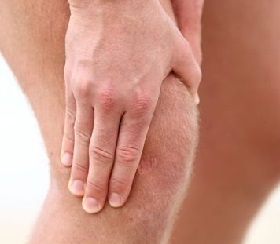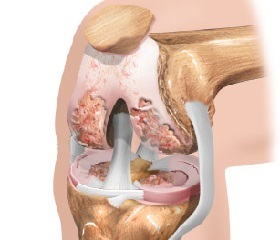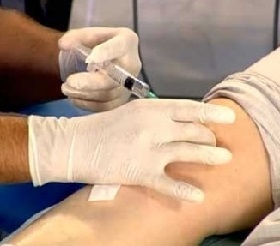 Deforming arthrosis of the knee joint in medicine is also called gonarthrosis, this disease is a degenerative-dystrophic disease.
Deforming arthrosis of the knee joint in medicine is also called gonarthrosis, this disease is a degenerative-dystrophic disease.
The disease is formed over time, it develops due to a constant load on the knee joint. The disease is more common in women than in men (approximately 2 times).
The first symptoms indicating the development of gonarthrosis - pain in the knee with prolonged walking, while descending the stairs, lifting and wearing weights. Such pains, as a rule, intensify in cold and damp weather. With the course of time, unpleasant sensations increase, acquire a permanent character.
What it is?
Deforming arthrosis is a disease associated with degenerative-dystrophic changes in cartilaginous tissue. In the medical literature it carries the following names: deforming osteoarthritis, gonarthrosis.
The process can arise independently (primary defarrots), and can be provoked by other diseases (secondary defarctosis). Treatment of deforming arthrosis of the knee joint of any shape is a complex and lengthy process, requiring patient patience and strict compliance with medical prescriptions. But before discussing the methods of healing in detail, let's consider the causes that lead to the emergence of this uneasy pathology.
Causes of development
What it is? Like many diseases, osteoarthritis has its own starting points, or triggers, due to which it begins to develop. Why there is a deforming arthrosis of the knee joint? The reasons leading to its development are the following:
- Increased stress on the support joints. Normally, most cases of osteoarthritis develop due to a sedentary lifestyle and the presence of excess body weight. As a paradox, you can determine a fairly high percentage of the disease in athletes engaged in complex sports (for example, wrestling or weightlifting). In this case, the deforming arthrosis of the right knee joint most often develops, since weightlifters usually use the right leg as a support.
- Presence of hereditary predisposition. This factor is often found in families with a hereditary anamnesis. Blame it all - the specific antigen - NVA-27.
- Injuries. Meniscal lesions, knee joint dislocation, shin fracture - all this can lead to knee deformation, due to which stagnant phenomena occur in the joint.
The causes of the disease with deforming arthrosis can be different and carry both hereditary and acquired character. To date, the development of pathology threatens almost every seventh person who has reached advanced age.
Deforming arthrosis of the knee joint 1, 2, 3 degrees
According to the severity of clinical symptoms and the degree of disruption of the function, these stages of arthrosis of the knee joint are distinguished:
- 1 degree, or the stage of initial changes. It is characterized by dull pain in the knee joint that occurs intermittently. Pain syndrome occurs after a load on the joint. A small swelling of periarticular tissues is possible. There is no deformation of the joint at this stage.
- 2 degree. The pain syndrome is longer, it is also characterized by greater intensity. In this case, patients note a "crunch" in the knee joint during movement, its stiffness in the mornings, which, however, passes after a short walk. Already at this stage, patients begin to use analgesics. There is an insignificant limitation in flexion and extension of the knee joint.
- 3 degree. It is accompanied by almost constant severe pain in the knee, and in any position, and even at rest. Very often the pain begins to worsen due to the weather change. The mobility of the joint is severely limited, when walking, lameness develops. The patient is not able to bend the knee, there is a progressive deformation of the joint.
Signs of arthrosis
Typical signs of the disease include:
- pain in the joint, turning into the lower leg;
- increased pain when walking on a ladder or prolonged standing;
- stiffness of the joint, feeling of tightness of the skin;
- the inability to move normally after sleeping or after a long sitting;
- knee swelling and crisp sound during movement;
- inability of the knee to fully straighten or bend due to pain;
- the cessation of painful sensations during rest (only at an early stage).
Symptoms of deforming arthrosis of the knees
 Reasoning about how to cure arthrosis of the knee joint, often talk about the importance of timely diagnosing the problem.
Reasoning about how to cure arthrosis of the knee joint, often talk about the importance of timely diagnosing the problem.
So, all specialists agree that it is much easier to stop the development of the disease, if it was identified at the 1 or 2 stages of development, but with the late diagnosis of this disease to achieve some significant results in the treatment is quite difficult. But the main problem is that in the early stages the disease manifests itself insignificantly, because people often simply ignore such signs.
Symptoms of deforming arthrosis - the occurrence of pain in the joints when walking and the appearance of a crunch when moving. External deformation of articulations develops during a long course of the disease. Inflammation of the periarticular tissues is manifested by 5 classic signs: swelling, pain, redness, increased skin temperature, limited mobility of the knee joint.
In the initial period of development of arthrosis, the pains are of a "mechanical nature". This means that the pain appears or intensifies mainly in the evening, especially after physical exertion. In the morning, after an overnight rest, the pain sensations decrease or disappear.
Over time, the intensity of pain gradually increases, the pain does not stop after an overnight rest. The appearance of the symptom of "morning stiffness" characterizes the attachment of inflammation of the internal (synovial) lining of the knee joint. In a sick joint, there may be a crunch and crackling during movements. Because of severe pain, a protective muscle spasm develops, it further restricts movement in the affected joints, up to the development of stiff stiffness (contracture).
Prevention
From posttraumatic arthrosis, alas, you can not defend yourself, as well as you can not predict the injury. However, acquired gonoarthrosis can be avoided.
Prevention is always easier than treatment. To prevent knee problems, you need:
- Balanced eat. Proteins, trace elements and vitamins should be present in the food in sufficient quantities.
- To lead a correct way of life and to try to get rid of bad habits.
- Maintain weight in the norm.
- To exercise were adequate.
- Do not forget about the prevention of injuries when lifting heavy objects and playing sports.
If the diagnosis of "gonoarthrosis" is confirmed by doctors, the most important thing is not to start the disease. Otherwise, it can lead to disability.
How to treat knee arthrosis deformans
 It is necessary to begin treatment at the first signs of the disease. Eliminating its cause, it is possible to eliminate and inflammatory changes, after which there is a chance of restoring the lost function of the affected joint.
It is necessary to begin treatment at the first signs of the disease. Eliminating its cause, it is possible to eliminate and inflammatory changes, after which there is a chance of restoring the lost function of the affected joint.
And it is worth considering that with deforming arthrosis requires a comprehensive treatment. At the initial stage of the disease - conservative, aimed primarily at reducing the pain syndrome and arresting the focus of inflammation.
In addition, therapy of the disease should be aimed at reducing morning stiffness and increasing joint mobility, preventing and eliminating violations in the function of the joint, the normalization of metabolic processes of the affected tissues, slowing down the further progression of the disease. In more serious cases, surgical intervention is used.
The main methods of treatment of deforming arthrosis of the knee joint are:
- Drug treatment;
- Manual therapy and massage;
- Orthopedic methods;
- Natural methods (medical gymnastics, kinesitherapy, etc.);
- Operative intervention.
The tactics of treatment depend on the degree of development of arthrosis. Most often, a combined approach based on several techniques is used.
- For the treatment in the first stages applychondroprotectors. They restore cartilaginous tissues and ligaments, favorably affect the structure of tissues. They give an effect with prolonged use, at least 3 months. To enhance blood circulation, vasodilator drugs are used. They help to avoid constriction of blood vessels and counteract the occurrence of varicose veins. Ointments, compresses and massage are effective in addition to the main course of treatment. After several procedures, patients note a reduction in pain, increased mobility of the joint and strengthening of the muscles in it.
- With deforming arthrosis of the knee joints at later stages, treatment is primarily aimed at relieving the pain syndrome. Choose such analgesics, which can be taken for a long time without affecting the digestive tract. It is mandatory to wear knee pads. At this stage, the initial mobility of the knee will not be restored, since the degenerative changes have become chronic. Therapy begins to be conservative in order to prevent further destruction of the knee and changes that occur with the bone tissue. Treatment of deforming arthrosis of the third degree of the knee joint is reduced to eliminating the causes of pathology.
- At a severe stage when the joint is badly affected perform another operation -endoprosthetics. The procedure involves replacing the worn joint with an artificial joint. Implants have their lifespan and after a while they will need a second operation and replace them with new ones. This operation is more serious than arthroscopy, so there is a chance of side effects (scarring, ligament damage). Therefore, endoprosthetics are performed when there are no other effective methods of treatment and the disease takes a severe irreversible character.
Remember that ignoring the recommendations of the attending physician is the main cause of the development of the disease and often leads to disability of the patient.
Diet
Deforming osteoarthritis of the knee requires the patient to adhere to a special diet. It is aimed at both reducing excess weight in its presence, and improving the supply of cartilaginous tissues. It is necessary to reduce the number of calories consumed, there are less flour and sweet. It is noted that when weight decreases, the symptoms of the disease decrease.
To maintain cartilage in a workable form, you need to consume more protein, vitamins and minerals. For such patients it will be useful to periodically use jelly, since it is rich in collagen, which is an essential component of cartilaginous tissue.
Treatment with folk remedies
With the help of an integrated approach, it is possible to achieve improvements in health, even if bilateral deforming arthrosis of knee joints is diagnosed.
- Tincture of dandelions. Fill a bottle of vodka with the heads of yellow dandelions. Give the solution to brew a month in a dark corner, strain it. Daily, before bed, rub the affected area of the knee.
- Compresses made of blue clay. A wooden spoon in gauze is applied a mixture of clay and water with a creamy consistency. This compress is imposed on the diseased knee and held so for two hours. Repeat every day with a new clay.
- Treatment with cabbage juice. You need to cut cabbage into pieces with a knife. Then cabbage mass must be passed through the juicer. At the output, you get ready cabbage juice. Next, woolen cloth should be soaked with cabbage juice and applied to the affected joint as a compress. Regularly repeat the procedure and update the cabbage juice, after 3 days it loses useful properties.
- Horseradish Root Compression. Grind the roots of common garden horseradish on a grater and put them to steam on a small fire, so that the water does not boil. The resulting composition put on gauze and apply a compress on the knee. Do such compresses for at least a month.
Competently and most importantly, timely treatment is the key to preventing a patient's disability.
Gymnastics at home
To maintain the performance of joints, it is necessary to perform a set of physical exercises aimed at strengthening okolohryshchevyh muscles and ligaments. The training time should be 30-40 minutes a day, and this time should be divided into several segments for 10-15 minutes. When performing exercises, a balance should be observed between the resting state and the time of stress on the joints.
Many people need to give rest to the affected arthrosis joints every 4-5 hours is necessary for the regeneration of the cartilage of the joint. Exercise smoothly, the amplitude of movements increase gradually. When doing exercises, focus on the aching joint, imagine how the blood flows to the knee and the joint is restored.

How to choose probiotics for the intestine: a list of drugs.

Effective and inexpensive cough syrups for children and adults.

Modern non-steroidal anti-inflammatory drugs.

Review of tablets from the increased pressure of the new generation.
 Antiviral drugs are inexpensive and effective.
Antiviral drugs are inexpensive and effective.



